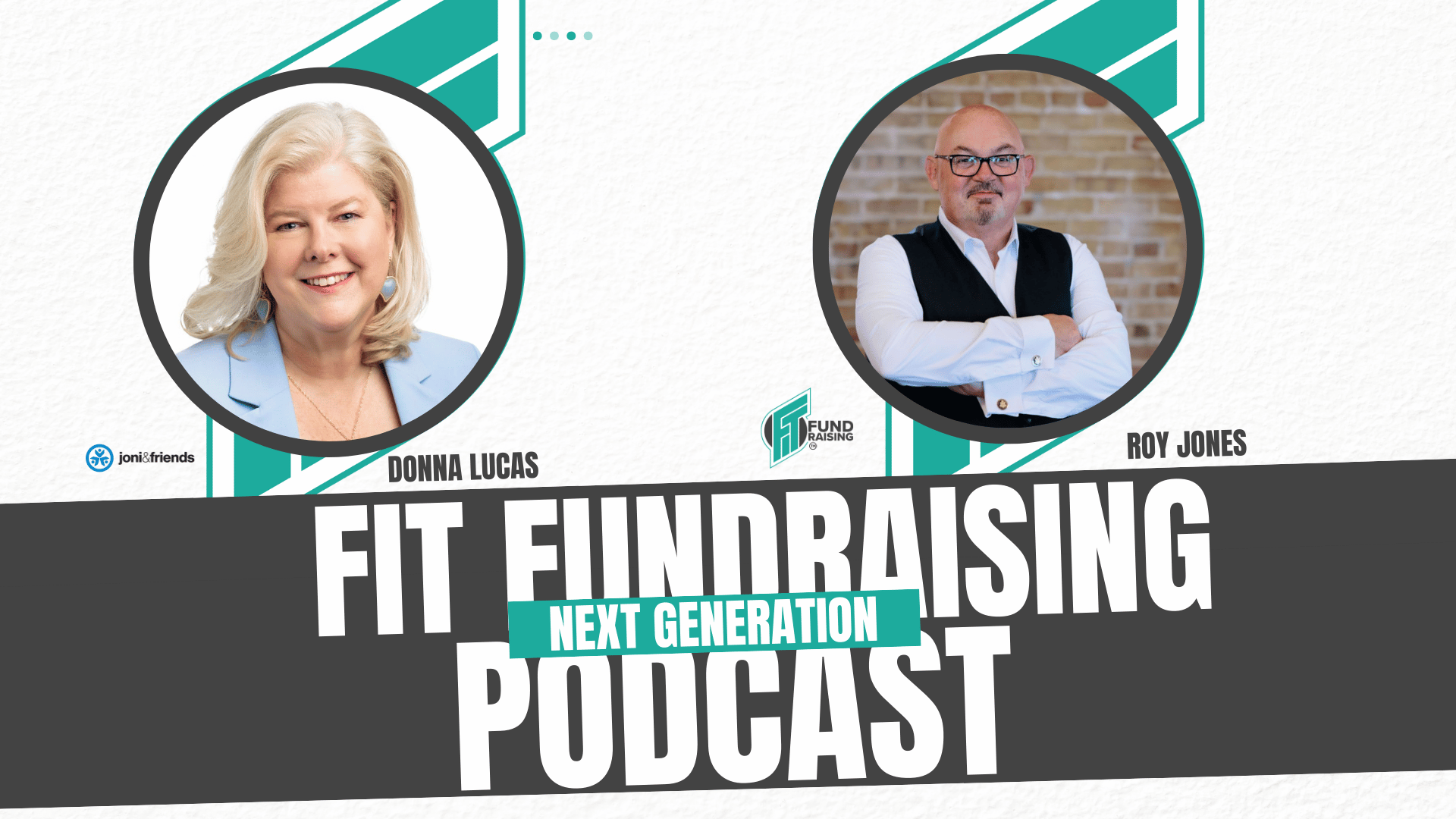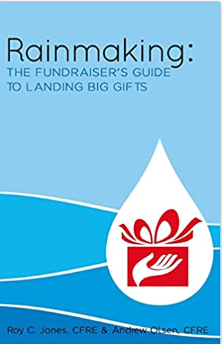Welcome to the Fit Fundraising Podcast, where we bring you game-changing fundraising topics, direct from our meetings with major donors and non-profits nationwide. While most consultants are busy giving advice, Fit Fundraising stays on the front lines with non-profits and major donors. This podcast is a glimpse into our world of work with non-profits as we get on the field with them and successfully model fundraising. Get ready to get fit with the hottest show in fund development, Fit Fundraising.
Roy Jones
Hi,this is Roy Jones and you’ve joined the Fit Fundraising Podcast. Thanks so much, for joining us today. We are going to have another exciting time and I’ve got a great guest today. We’re going to be attacking head on what’s going on in our economy right now and how it’s impacting nonprofit organizations. So let me just jump right into it.
Donna Lucas is the marketing officer of Joni and Friends in their International Disability Center. Donna spent more than 30 years working in product development, marketing, brand management for such powerhouse brands as Adidas USA, United Colors of Benetton, K-Swiss, the Dickies Workwear brand at VF Corp. As a strategic brand and marketing executive, she is an expert, trust me when I tell you that.
her years of experience with high profile brands and strategy, her leadership at Joni and Friends have well positioned her and the ministry for a long future. Donna holds a bachelor’s degree in, a bachelor of arts degree and a master’s degree in marketing from Philadelphia University. She’s a mom of three incredible daughters and lives in Southern California with her husband, Jack. Donna, welcome to the Fit Fundraising Podcast.
Donna Lucas
Thank you so much,, Roy. What a blessing it is to be here today. Just a great opportunity.
Roy Jones
Literally, just before this call, it was just on the phone with the vice president of development. The board and president in this economy had cut his budget by about 30%, but yet increased his goal by $2 million this year. I’m curious to get your insight as a chief marketing person, how do you rally not only your team, but your upline and your board in tough times like this to to not step back, but to step in and lean into this.
Donna Lucas
What do I feel for that VP of Development? Wow, that’s really difficult. I think for me, the way, I would look at it two different ways. The way I lead our team, I think with our development officers, our major gift officers, our donor care team, those people on the front lines, they need a rallying call right now. They need to know that I have confidence in them, that I have confidence that they’re doing the work.
that what they’re doing is making a difference. I want to hear their little wins. Even if they’re little wins, I want to start seeing some wins for them. They have to see that. for that level, I think it’s really important that there’s a rallying cry for them. As I look at the executive leadership teams and our executive leadership team, it’s about sharing vision with them. I think for me as the CMO, as I try as I try to lead them. I want to be looking ahead.
This role, CMO, Chief Development Officer, Chief Marketing Officer, whatever your executive leadership position is, you need to be looking ahead and you need to be looking at data to tell you what has happened and what people are doing. But you also need to combine that with what do I anticipate is coming at us and preparing. And I’ll give you an example. About two years ago, we were looking at internally at Joni and Friends and seeing the organization has been very blessed and we’ve been on an exponential growth spurt over the last seven years. And we’ve seen this seven years of exponential growth, not only from a fundraising perspective, but just ministry growth.
And as I looked at it and I then looked ahead at what people are saying are happening, what’s coming down the road, what’s happening in the environment in the United States around us, I saw a plateau coming. And honestly, Roy, anyone in business knows, right? You could have so many years of growth and it’s a business must. You have to have a plateau, right? You have to stabilize at some point and make sure that you are ready for that next level of growth.
So I’ve actually been working with my team for almost a year preparing us for when we do hit that plateau. And as you mentioned earlier, this first quarter, this first four months of the year have been challenging from every perspective. so going into it, they were expecting that it would happen because we’ve been looking so far ahead for a year now and really planning what are we going to do when we do hit that?
You know, how are we going to, how are we going to encourage our donors? What are we going to do to instill confidence in that donor base? And so I feel like we have a plan for how to manage through any kind of a plateau. And that, think, is critical. as chief marketing officer, chief development officer, it’s that look forward. Back to that very first question we talked about, look up, look around you. What’s coming your direction? What is that headwind that’s coming towards you and preparing for it?
And that’s, think, the difference between a development officer, a major gift officer, or a major gift strategist, and that executive leader position. You have to be looking at the landscape around you.
Roy Jones
I love it. love it. Let me jump back in the weeds a minute. Everything that’s going on, especially with, with, with AI and how that is helping us with segmentation and targeting with our donor files. What are the things that you would do differently in a down economy with segmentation targeting, know, to determine who you’re reaching out to, who you’re mailing.
who you’re tailoring messaging to and what that message might be. How are you using AI and data itself, big data, I guess, to really hone in and target the right people with the right message.
Donna Lucas
Yeah, I think that for some people, AI is a scary thing, but they have to think of the fact that we’ve really been using AI for a decade, right? In targeting lists, in targeting messaging, everything that we do digitally is AI-driven, if it’s algorithm-driven. Right. It’s not user behavior, right?
Roy Jones
We just gave it a name that people like now with it, that’s starting to catch on. Right. We’ve been doing it for decades.
Donna Lucas
Right. So first of all, don’t be afraid of it. You’ve been using it all along. It’s just getting better and better and better. So I think that’s my first challenge to people is don’t be afraid of AI. There’s a difference between AI that helps you segment and generative AI, which creates things from scratch. I think that AI has really been, we’ve used it a lot to help with, I’ll say things like, even simple things like taglines.
What are the best terms for SEO? Using it to really dig into some of the digital elements that will help us find and connect with people better. use it for help us get started in writing, but from a segmentation perspective, I’m a huge believer in segmentation. The more segmented, the smaller your list, the more direct you can be in your communication, right?
Lists gets too big and too broad. Now all of a sudden your communication has to be broad. I would rather send more targeted emails to smaller audiences than anything. so I think using AI to help us segment those lists even deeper so our communication can get more specific, can drive in more to who that donor is, then they know that we know who they are.
And I think they know then that we know what they value. We know how they want to hear us. And it helps us cut through the generalities and be able to get very specific in who we communicate to and what we say to them. so we’ll send things out to real small lists of people because I know this list has an affinity. And we use AI to help us understand that.
Roy Jones
Good. Excellent. Talk to me about, you know, doing more targeting, getting the segment smaller and smaller. Ultimately, my background is in major gift development and specifically interested just to hear how your role as a chief marketing officer is focused on empowering and making more successful your frontline fundraisers doing the face-to-face engagements with top donors. How does all that work together?
Donna Lucas
Our frontline people, they’re in communication, of course, every single day, right? You know, as a major gift fundraiser, it’s all about the relationship. It is all about, they know about their families, they know when their kids have birthdays, they’re talking to them daily about their life and their living life with them.
For our team, we see, especially our major gift officers, but all of our development team, we look at development as part of our ministry. To us, living life daily, being able to be in their lives, understand their lives, pray with them, know what’s going on in their lives is critical. And we see that as ministry where the rest of our organization is doing ministry and they’re out in the field and they’re serving families with disabilities and people with disability that delivering wheelchairs or doing family retreats. Our team is praying and loving on and caring for donors.
And that is our ministry. And we look at it. And we value it from that perspective as this is something we are called to do. And I think that makes it different for them. It’s not a job. This is a ministry they’re called to. from that perspective, also, I engage with them every single day.
As the chief marketing officer, they see me every day. They talk to me all the time. We have a fun thing that I do when I have one-on-one time with every one of them where I call it three, two, one, right? Tell me three things you’re proud of, two things that surprised you, and one thing that challenged you. And so whether it’s this week, this month, since the last time we talked, three things you’re proud of, two things surprised you, one thing that challenged you.
And it forces them to look for the wins. It forces them to look for the sweet moments they’ve had with a donor and to really focus on those rather than the challenging call or the challenging person that they may have come in contact with. So I like to really continue to encourage them that this is a ministry. This is their ministry.
Roy Jones
Tell me that again. Three, two, one. What’s that mean?
Donna Lucas
Three things you’re proud of, two things that surprised you, and one thing that challenged you.
Roy Jones
- I love it. Tell me, what sort of communications do you do with higher end donors compared to, what do you do differently for a $10,000 donor compared to a $100 donor? How are you communicating with them?
Donna Lucas
With our major gift officers, it’s all personal. It is personal text messages, personal phone calls. It’s truly one-to-one. We do not mass market or mail to our major donors with exception of our full color newsletter. That newsletter does not have any kind of an ask or anything in it. It’s just ministry information. We really don’t market to them. It is a one-on-one communication.
And we are blessed that we have a large group of those people. one of the reasons I’m here in South Carolina is I am here with a major gift strategist and we are visiting face-to-face dinners, lunches, coffee with major donors in this area. And we do this probably around the country four times a year or five times a year, as well as our in-person fundraising events. So it’s very much a personal one-to-one connection with a major donor.
When you get down to a thousand dollars and below that general donor, we have a team that tries to cultivate them. We have tried to make it more personal there, even though you can’t have one-to-one conversation, but they have a name and a face. So even if you give $20 a month, then you have a face of a person that you know at Joni and Friends that you can connect with.
If you give us a hundred dollars a year, 250, whatever that…whatever that amount might be, we put a name and a face to the communications. Even if it’s an email newsletter, an email communication, it comes from an individual that they will see consistently because we’ve created what we call a book of ministry. And so, you we have people that have a book of ministry for everyone that’s given us, you know, $500 and below or $500 to a thousand, and they are communicating on a more mass level with them but from a very personal perspective. Even to the point where we.
Roy Jones
I love that term. did, have you guys always used that for who manages? You hear a lot of times people call it a portfolio or a caseload, but a of ministry.
Donna Lucas
We call it a book of ministry and that absolutely comes from our focus that this is ministry, that we are ministering to people. so their book of ministry is their collection of donors and sustainers or monthly sustainers that they are responsible for. And this is the ministry that they’re called to do.
And so we do call it a book of ministry. And even though they are sharing via some large channels like email ⁓ blasts or things like that. We also ask them, know, be personal with them, share something that touched your heart this week. So they start to get to know, you know, Lisa on the bottom of the email or Jesse on the bottom of the email.
They start to get to know a little bit about them. ⁓ And so we try and make it as personal as possible within that knowing that this is a huge, I mean, they’re managing thousands and thousands of donors. So It’s as personal as you can get in that perspective.
Roy Jones
Sure, I love that. Well, it has been an amazing time, Donna. We are out of time. It’s been a wonderful conversation. Thank you so much, for joining us today and sharing your insights and guidance. If our listeners wanted to find out more about your ministry or reach out directly to you, how would they get in touch with you? How would they do that?
Donna Lucas
Well, our website is Joniandfriends.org. That’s easy to find. They can private message me on LinkedIn,, Roy, or email is always an option and maybe you can drop that in the notes, the email address, but that’s always an easy way to get a hold of me.
I do look at LinkedIn so they can private message me on LinkedIn, I’m happy to connect with them from that perspective.
Roy Jones
Great. And so on LinkedIn, it’s just Donna Lucas. Fantastic. Well, Donna, thank you so much,. It is just, I’m so blessed, honored. I first met Joni in 1977. That’s been a while ago.
This has been a blast from the past for me, but also a blast into the future. The kind of vision casting that you do with your team and with your marketing strategies is just so inspirational.
Donna Lucas
Donna Lucas, yeah.
This has been a lot of fun, Roy. Thank you for inviting me.
Roy Jones
Oh, it is, it is our honor. I want to close just by encouraging our listeners, please, please, please reach out to fitfundraising.com. Last year, we helped more than 300 nonprofits with free fundraising counsel, whether it is a pro bono campaign or just a specific counseling hours. We’re here to help.
We do have 15 or 20 paying customers and most of those started out as, as, somebody that asks for free fundraising counsel. So I don’t want to hide that from anybody. We are in the business of making money, but we’re in the business of helping people.
You know, I’m going to still don his term here. We’d love you to be part of our ministry. Again, thank you so much,. Thanks for joining us here on the Fit Fundraising Podcast. We’ll see you next time.
Outro
Thanks so much, for listening to the Fit Fundraising Podcast. Please make sure to subscribe on your favorite podcast app so you’ll be notified of future episodes. And as always, make sure to visit fitfundraising.com to get your fundraising program into shape.
- Follow Us: Facebook | LinkedIn
- Subscribe to the Fit Fundraising Podcast: Apple Podcasts | Spotify
- Visit our Website at fitfundraising.com


